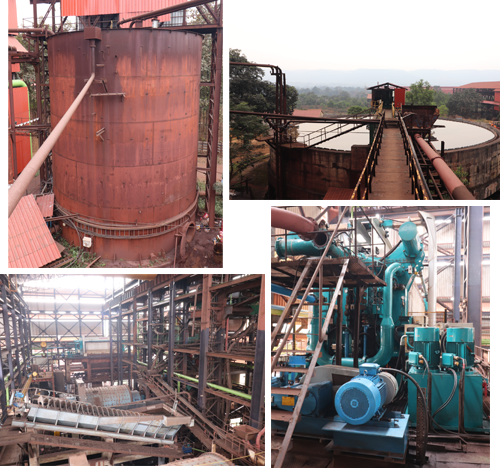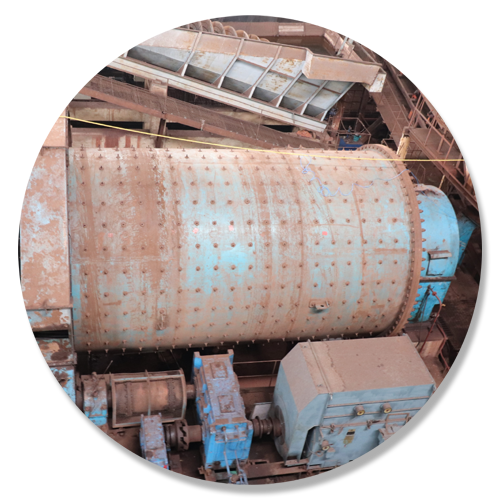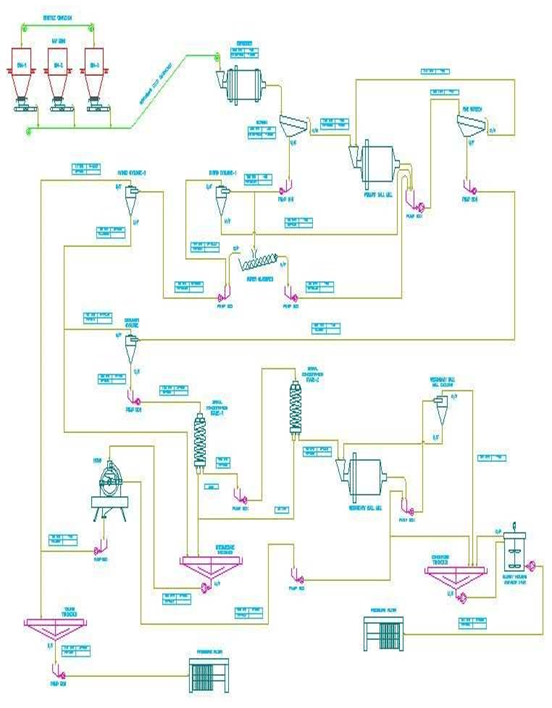
Features of 1.5 Million MT capacity Iron Ore Beneficiation Plant
Recently commissioned with annual installed capacity of 1.5 Million MT located in the Mineral Belt with a huge potential for forward and backward Integration.
Iron Ore Beneficiation Plant which is designed to produce pellet grade iron ore concentrate with Fe range of about 63 - 64%. The plant is designed to use low grade hematite iron ore fines of 56 to 58% Fe in Orissa region. The product will be sold out in the market to manufacture iron ore pellets.
The process includes selection of effective grinding technologies, magnetic separation techniques for the Fe upgradation and finally to produce the desired density in the product in the form of concentrate slurry for pumping. This wet beneficiation plant for producing high-grade iron ore concentrate requires scrubber, screens, grinding mills, spiral classifiers, hydro-sizers / hydro-cyclones, magnetic separators, agitators, , filters and thickeners.
The most important beneficiation processes are :
- ❯ Gravity separation (using difference of mineral specific gravity).
- ❯ Physico-chemical separation (using surface characteristics of the minerals).
- ❯ Magnetic separation (using inherent properties of the mineral for separation)


Benefits of Mineral Beneficiation :
The Fe grade is slowly deteriorating in the mines and cost economics between high grade and low grade ore, beneficiation process is becoming essential. Some major advantages of ore beneficiation is given below :
- ❯ Increased productivity in down stream operations.
- ❯ Conservation of natural resources – Can cater upgrading of low grade and complex ores, which would have been otherwise considered to be uneconomical to be utilized.
- ❯ Increased mine life – in view of handling geological complex and low grade ores.
- ❯ Inexpensive operations.
- ❯ Decreased environmental pollution – Waste management (low grade ores discarded in mines still having potential for further upgradation) decreased dumpsites; decreased blasting requirement; lesser air, water and noise pollution etc.
The Beneficiation process adopted in the plant is of wet process concept which has various benefits over dry process.
Wet beneficiation techniques are widely adopted for beneficiation, as water being universal solvent, easily available, facilitates as a good medium having intermediate specific gravity for separation of heavy and light minerals and also is a good medium for transportation. Also water can be recovered from the process and hence creates less environmental pollution.
the overall yield expected would be in the range of 80% to 85% with an acceptable grade of 64% Fe in the concentrate.
The unit processes considered is as under :
- ❯ Washing by scrubbing.
- ❯ Size Classification by screening operation.
- ❯ De-sliming of screened undersize product.
- ❯ Size reduction by grinding.
- ❯ Gravity concentration by use of stationary spiral concentrators after de-sliming ground product.
- ❯ Recovery of escaped iron units from de-sliming operation by high gradient magnetic separation.
- ❯ Size reduction of finished concentrate product by grinding to meet pellet requirement.
- ❯ Dewatering of concentrate for recovering water for re-use in the process.
- ❯ Dewatering of tailings for easy disposal and environmental control.
- ❯ Filtration of partially dewatered concentrate to produce cake with moisture required for pellet making.
Process Flow Diagram :

Equipment Description
The rotary scrubbers are supported by four trunnion rollers, and usually installed horizontally or inclined. The cylinder rotates at a low speed with the motor and reducer driving the large and small gears.
The ore is fed from the feed inlet through the feeding device and the ore entering the rotary drum is washed by the high-pressure water, materials are constantly lifted, dropped, stirred, so that the ore and slime are completely separated. After fully cleaning, the ore is discharged through spiral discharge liners.
The screen is a surface with aperture of given dimension. Raw material / ore fines of mixed size are fed to the screen to separate the material according to size of particles. The screening efficiency is determined by the degree of perfection for the separation of material into size fractions above or below the governing dimensions.
Grinding Mill with spherical ball charge are used in mineral processing plants to grind coarse ore. The mill is operated in closed circuit. The purpose of grinding is to reduce the ore to a size small enough to liberate and recover the valuable iron bearing minerals. Closed circuit grinding minimizes over grinding. Higher the re-circulating load, lesser is the possibility of over grinding of particles. For this reason, the ball mills are operated at nearly 200% - 300% recycling load. The grinding process achieves two goals, first to achieve the liberation size for upgrading and second to meet the Blaine index desirable for further process of the concentrate. The grind size is very important and its mainly determined on the type of further agglomeration process like pelletizing / sintering etc.
Spiral classifier is a simple equipment which can separate finer ore particles from the coarse feed ore. A rotating shaft with spiral blade located in a water sump. The gap between the sump body and the edge of the spiral screw is adjustable as desired by the process operator. Feed ore with the water are fed to the classifier sump. The rotating screw separates the coarser particles which cannot pass through the set gap are moved to the top of the screw and discharged in to the conveyor feeding the ball mill for grinding the coarser particles. The set screw gap, speed of the rotation and the percentage solids in the sump will determine the efficiency of the classifier.
Conventionally, the modelling and simulation of classifiers and cyclones are based on 50% separation size commonly known as d50 size. However, the design and construction of mechanical classifiers are primarily based on limiting / elimination size. The metallurgical performance depends on the key hydro-cyclone variables, such as pressure, feed density, size of vortex and apex. Depending on the ore characteristics, operating parameters of hydro-cyclone can be altered to improve performance.
High gradient magnetic separators are known for its efficiency in separation of feebly magnetic minerals. An electromagnetic field is generated within the separating zone. A carousel, rotating on its horizontal axis, houses a matrix of paralleled rods. From the feed box, slurry is introduced into the matrix as it passes through the separating zone. The magnetic particles in the slurry are attracted to the surface of the rods in the matrix then carried out of the separation zone to the top of the carousel. Once outside of the separation zone, where the magnetic field is negligible, the magnetic materials are flushed into the concentrate box. Conversely, while the matrix is still in the separation zone, gravity and the force of hydrodynamic pulsing of the slurry drag the nonmagnetic particles through the matrix pile into the tailings box.
Thickeners are used to continuous dewatering of a dilute slurry whereby a regular discharge of a thick slurry of uniform density took place concurrently with an overflow of clarified water. Thickeners are normally a RCC Construction with Taped cone design with rake mechanism.
Scraper blades or rakes, driven by a suitable mechanism, rotating slowly over the bottom of the tank, which usually slopes gently toward the center, move the material settled on the bottom to a central opening or discharge. The rakes revolve at a speed sufficient to move the material as fast as it settles without enough agitation to interfere with settlement.
A filter press is a piece of equipment used in liquid/solid separation. Specifically, the filter press separates the liquids and solids using pressure filtration, wherein a slurry is pumped into the filter press and is dewatered under pressure. Basically, filter press is designed based on the volume and type of slurry that needs to be dewatered. The four main components of a filter press include the frame, filter plates, manifold (piping and valves), and filter cloth, a key ingredient for optimizing filter press operations.
The working principle of filter presses is that slurry is pumped into the machine such that solids are distributed evenly during the fill cycle. Solids build up on the filter cloth, forming the filter cake; the filtrate exits the filter plates through the corner ports into the manifold, yielding clean filtered water.
A Slurry pump is a special type of pump able to handle slurry. Unlike water pumps, are slurry pumps are subject to wear and are more robust and heavy duty. Centrifugal slurry pumps which can deliver high capacity with limited head are mostly used in pumping slurry through pipelines at concentrations below 70% solids by weight. Centrifugal slurry pumps could be vertical, horizontal or submersible.
Belt conveyors are the most common mode of transport system adopted in mineral process plant. Reasons being flexibility in selection on the basis of conveying capacity, elevation, distance type of material.

